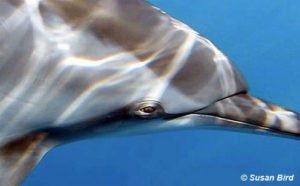 SPINNER DOLPHIN
SPINNER DOLPHIN
Kingdom: Animalia
Phylum: Chordata
Class - Mammalia
Order - Cetacea
Suborder - Odontoceti
Family - Delphinidae
Genus - Stenella
Species - longirostris
(Gray, 1828)
DERIVATION: from the Latin longus for "long" and rostrum for "beak, snout."
Four subspecies are recognized:
S.l. longirostris - oceanic tropical waters worldwide
S.I. orientalis - offshore eastern tropical Pacific
S.I. centroamericana - coastal eastern tropical Pacific
S.I. roseiventris - southeast Asia and northern Australia
Characteristics: It is slender species with an extremely long, thin beak and a very slender head, the flippers are slender and recurved. They have 40-62 pairs of very fine, pointed teeth in each jaw with some differences between subspecies. These are more teeth than in any other cetacean species, with the exception of franciscana and some long-beaked common dolphins. Their color consists of shades of dark gray, light gray, and white. Most spinners have white bellies.
Life Cycle: Gestation is about 10 months. Average length at birth is about 75-80cm. Nursing lasts 1-2 years; calving interval is about three years. Female sexual maturity is at 4-7 years; male sexual maturity is at 7-10 years.
Feeding: Most spinner dolphins are night feeders. They feed on many midwater fish of different families, squids and sergestid shrimps and rest during the day. Dwarf spinner dolphins (S.I. roseiventris) presumably feed during the day on small, reef-associated organisms (benthic reef fishes and invertebrates).
Behavior: School sizes vary greatly, from a few dolphins to a thousand or more. Spinner dolphins school with pantropical spotted dolphins, S. attenuata, as well as dolphins and small toothed whales of other species and even with dugongs (Psarakos et al., 2003; Kiszka, 2007).
No one knows why the spinner dolphin spins. This marine mammal is capable of spinning seven times on its axis. The spin begins with a powerful acceleration under the water and the torque of the tail just as the dolphin breaks the surface. Some theories are that spinning:
- serves as an echolocation target for communication across a widely dispersed school (Norris et al., 1994);
- could be an outgrowth of an alert state and may possibly be a social facilitation function;
- could represent play; and
- could dislodge remoras, as the rotation rates and orientation of the dolphin’s body during re-entry into the water could achieve this (Fish et al., 2006).
The whistles and burst pulses of spinners have been studied extensively for the past several years (Lammers et al., 2006). They vary in complexity with the animals’ geographical location and their activity. Their functions are only beginning to be understood.
Distribution: They may be found resting in the sandy-bottomed bays of oceanic islands and coral atolls, but much of their range is oceanic, particularly in the eastern tropical Pacific. The dwarf spinner (S.I. roseiventris) may be found almost exclusively in shallow waters in southeast Asia and northern Australia. It appears to feed over shallow reefs. They are found in the Red Sea and Persian Gulf but not in the Mediterranean Sea.
Threats and Status: Sharks and orcas (killer whales) are threats, but humans have done the most harm. Since the early 1960s, large numbers have been killed by tuna purse seiners in the eastern tropical Pacific. The population of S.l. orientalis is estimated to have been reduced to less than one-half of its original size. Since the reduction of reported purse-seine mortality more than a decade ago, the population has grown at an annual rate of less than 2% which is lower than the expected rate of about 4%. High rates of bycatches in drift nets and purse seines occur in the Philippines that is unsustainably high. Concern is growing over harassment by dolphin-watching boats in several localities in Oceania and Southeast Asia (IUCN Redlist).
 Definitions:
Definitions:
- benthic - relating to the bottom of a sea or lake or to the organisms that live there.
- cm - a unit of length in the metric system, equal to one hundredth of a meter (equivalent to 39.37 U.S. inches).
- recurved - curved backward or downward.
- sergestid shrimps - Sergestidae is a family of prawns which have lived since at least the Albian age (Cretaceous).
References:
Fish, F.E., A.J. Nicastro and D. Weihs. 2006. Dynamics of the aerial maneuvers of spinner dolphins. J. Exp. Biol. 209:590-598.
Jefferson, T.A., M.A. Webber and R.L. Pitman. 2008. Marine Mammals of the World: A Comprehensive Guide to Their Identification. Academic Press/Elsevier, 573 pp.
Kiszka, J.J. 2007. Atypical associations between dugongs (Dugong dugon) and dolphins in a tropical lagoon. J. Mar. Biol. Ass. UK 87:101-104.
Lammers, M.O., M. Schotten and W.W.L. Au. 2006. The spatial context of free-ranging Hawaiian spinner dolphins (Stenella longirostris) producing acoustic signals. J. Acoust. Soc. Am. 119:1244-1250.
Leatherwood, S. and R. Reeves. 1983. The Sierra Club Handbook of Whales and Dolphins. San Francisco: Sierra Club Books, 302 pp.
Norris, K.S., B. Würsig, R.S. Wells and M. Würsig. 1994. The Hawaiian Spinner Dolphin. University of California Press, Berkeley. 408pp.
Perrin, W.F., B. Würsig and J.G.M. Thewissen. 2009. Encyclopedia of Marine Mammals, Ed. 2. Academic/Elsevier Press, Amsterdam, NL. 1316 pp.
Psarakos, S., Herzing, D.L., and Marten, K. 2003. Mixed-species associations between pantropical spotted dolphins (Stenella attenuata) and Hawaiian spinner dolphins (Stenella longirostris) off Oahu, Hawaii. Aquat. Mamm. 29:390-395.
